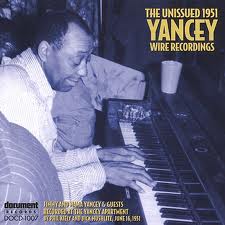I’m not completely pleased with what the purchase of a Jimmy Yancey CD revealed about me.
I was looking to acquire more Yancey recordings, no doubt. During a car trip with my wife, I had played several discs from a blues anthology which included some Yancey. Every time he came up, she started tapping her foot along with the music. She responded equally well when I played a whole CD of Yancey for her. (It turns out she likes boogie woogie in general.) But I had only two Yancey CDs.
Does that matter? Yancey is a special case. I think of him as the Thelonious Monk of boogie woogie, a musician who despite an apparently limited technique managed to create compelling music. But unlike Monk, Yancey had a very limited repertoire. Many of his recordings are almost exactly the same music with different titles. One of the Yancey CDs I already had was Vol. 1 of a complete edition of his 78s, which runs to three discs. But there is so much repetition on Vol. 1 that I never felt compelled to buy the other two. (The other one I already had includes several items on which Yancey accompanies his wife in some creaky but tasty blues.)
Still, knowing I didn’t need any more Yancey, I still went looking at listings and found something I could not resist: “The Unissued 1951 Yancey Wire Recordings.” They were made at Yancey’s home, shortly before he died, at a small party. Conversation interferes with some of the music. Some of the recordings were damaged and have a lot of noise on them. And some of the music isn’t even played by Yancey. It’s played by other people who were at the party, the first four items by someone whose name nobody involved in the production could remember.
As soon as I read about this CD, though, I had to have it. I didn’t know about the limitations I’ve mentioned above until I got the disc, but I didn’t care. It was magic, Yancey that nobody had ever heard until this CD was issued. And the idea of wire recordings resonated strongly with me because when I was a kid my family had a wire recorder. I remember it as a low-fi medium, and the recordings on this CD are certainly not state-of-the-art for 1951. But they sound better than I would have expected.
So what does this CD add to my appreciation of Jimmy Yancey? Hardly anything. Actually I got more of interest from the extensive booklet than from the recordings. Yancey’s only known vocal is on one of these items (“Royal Garden Blues,” not typical Yancey repertoire), but it’s nothing special. I just had to have it, though. And having heard it and realized the limitations of its interest–I can’t even play it for my wife, who would probably find it annoying–I’m still not going to get rid of it.
That’s who I am. I’m a collector. I’ve managed to get a little more rational about this in recent years, but not enough.
While looking through my small boogie-woogie collection, though, I did revive my interest in a similar item from the same CD label, Document. It’s “Pete Johnson: The St. Louis Parties of July 30 and August 1, 1954.” Johnson is a very different musician from Yancey, an amazing virtuoso who could seeming play almost anything. On recordings he was typecast as a blues and boogie-woogie pianist, and there’s nobody better. But on these party recordings, Johnson plays a much wider range of music and shows us how good he could be with material like “Stardust” and “Perdido.” (He even plays “Yancey Special,” jokingly including references to other songs.) That’s the kind of revelatory recording that I don’t feel I need any excuses for keeping.
